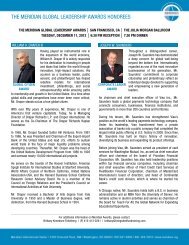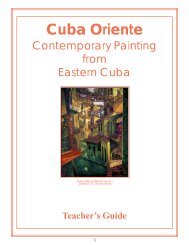Exploring the Great Outdoors - Meridian International Center
Exploring the Great Outdoors - Meridian International Center
Exploring the Great Outdoors - Meridian International Center
Create successful ePaper yourself
Turn your PDF publications into a flip-book with our unique Google optimized e-Paper software.
“30 Second Look”<br />
Classroom Use: Select an art reproduction of a detailed, realistic work of art with a<br />
narrative content.<br />
Objectives:<br />
The student learns:<br />
• that it takes time to notice details of a work of art. (Knowledge)<br />
• how to practice visual recall and compare perceptions. (Skill)<br />
• that looking carefully can be fun and rewarding. (Attitude)<br />
Description: In this activity students are guided to think about <strong>the</strong> effects of time on<br />
successful looking.<br />
The Procedure:<br />
1. Ask your students how long <strong>the</strong>y think <strong>the</strong>y might spend, on average, looking<br />
at a work of art. Record <strong>the</strong>ir responses and discuss <strong>the</strong> factors <strong>the</strong>y believe affect <strong>the</strong><br />
amount of time <strong>the</strong>y spend looking. Ask students how long <strong>the</strong>y think that adults spend,<br />
on average, looking at a work of art. Record <strong>the</strong>ir responses and discuss why <strong>the</strong>re may<br />
be a difference between an adult’s and a child’s looking. After students have answered,<br />
explain that research indicates that <strong>the</strong> average time that adults spend looking at one<br />
object in <strong>the</strong> galleries is less than half a minute. Is thirty seconds ample time to spend<br />
with a work of art Why, or why not Try <strong>the</strong> following experiment in small groups to<br />
test <strong>the</strong>ir answers.<br />
2. Direct students to sit silently in front of a work of art looking at it for thirty<br />
seconds. At <strong>the</strong> thirty second mark ask everyone to turn around facing away from <strong>the</strong><br />
work of art (in <strong>the</strong> classroom a slide could be used).<br />
Gallery Activities<br />
3. Without looking back at <strong>the</strong> work of art, ask students to use <strong>the</strong>ir memories to<br />
answer questions based on <strong>the</strong>ir observations. The following questions are <strong>the</strong> kinds of<br />
questions <strong>the</strong> teacher might ask:<br />
How many people are in <strong>the</strong> work of art<br />
How would you describe <strong>the</strong>m<br />
How is each one dressed<br />
What are <strong>the</strong>y doing<br />
What kind of setting is depicted<br />
Is <strong>the</strong> scene tidy or chaotic<br />
Are <strong>the</strong>re any animals in <strong>the</strong> work of art<br />
How would you describe <strong>the</strong>m<br />
29








